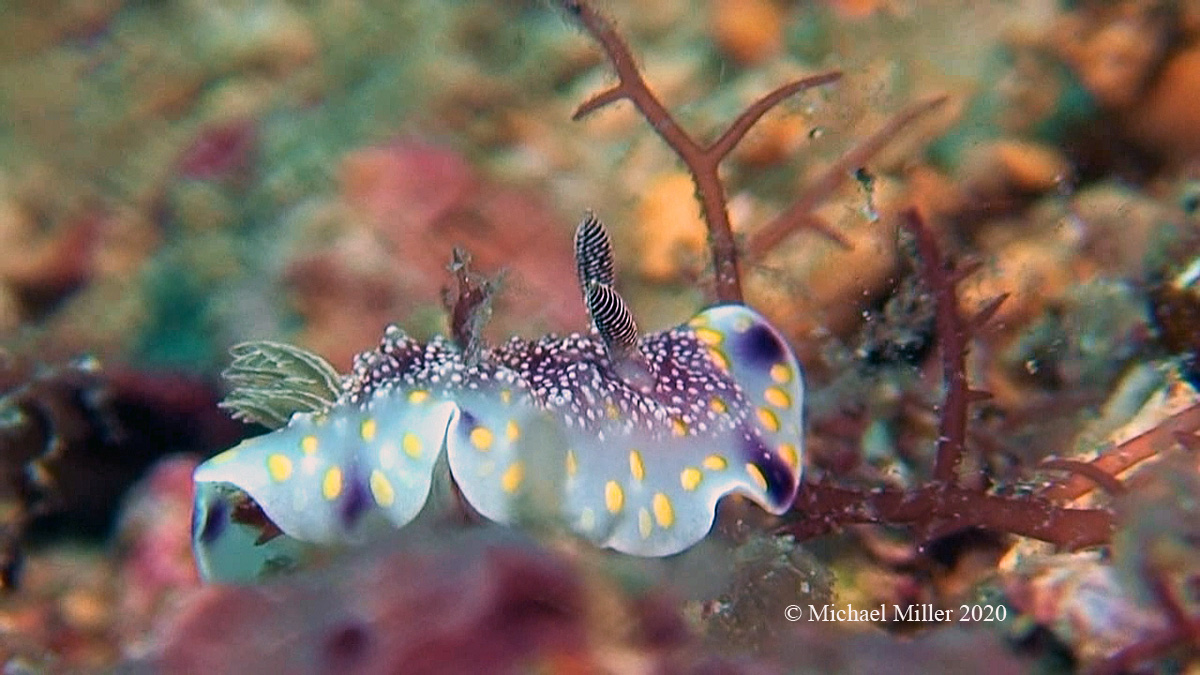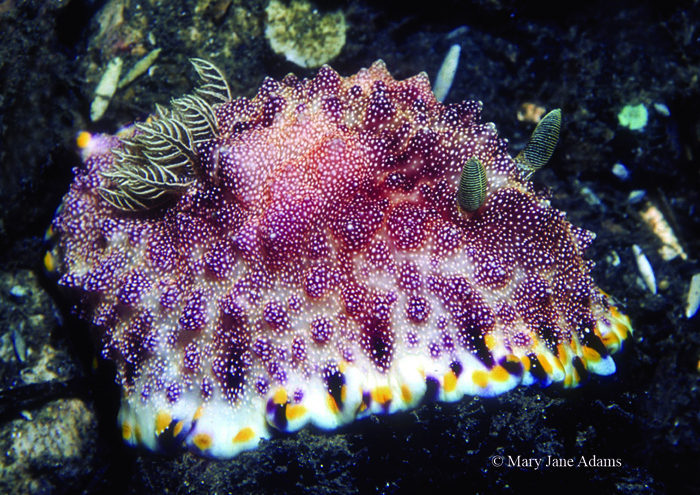 |
Image courtesy of Michael Miller (Webmaster)
Anilao, Philippines
May. 2016
Video Freeze Frame
 |
Goniobranchus sp. 25 (in NSSI 2nd Ed.)
A few years ago, master UW photographer, Kevin Lee, and I published an article titled - "Young versus Old: Deceiving Appearances of Marine Animals" in SCUDA Diver - South Korea magazine." The article discussed how growth in some species leads to changes in appearances of the individual - whereas humans growth, from infant to adult, is basically just an increase in size, for many oceanic creatures the path to adulthood goes though several iterations making juveniles change color over time. There are many examples of this in sea slugs, most notably in the Spanish Dancer, (Hexabranchus) . When Webmaster Mike showed me his latest video, I was struck by the image above which I was certain was a new undescribed species. My hastiness proved wrong. It took me some time scratching my graying skull, but when I viewed the critter through my Superman X-ray eyes (you can do the same) I saw characteristic bits of color, seen in another species, but not necessarily the same size, or in the same places. The size ratios seemed off to me. Finally Mike pointed out his first presentation of this species in BOW 649 listed as Chromodoris sp. The inset photo by Gramal Arno, set me straight. An "Ah Ha" moment - this was a juvenile, not a new species. Comparing Mike and Gramal's shots to Mary Jane Adams adult photo (left) from page 151 in NSSI 2nd Ed., we can see that if we changed the ration of the width of the wide white marginal area with yellow and blue spots in the juveniles, we get quite a different look. In Mike and Gramal's photos, the marginal band is wider than seen in Mary Jane's photo, and spread the brown region with the white specks is much larger. That noted - the colors and distribution of the spots are identical. Also to be noted that as individuals grow the dorsal tubercles become large and taller. The main things that change are the width of the band and size of the spots. Now we have it - the young of this new Goniobranchid changes appearance quite dramatically with age. What is to be learned from this? - Identifier beware. |
Dave Behrens
Sammamish, WA 98074
Sept., 2020
Send Dave Behrens email at davidwbehrens@gmail.com
Send Mike Miller email at mdmiller1@cox.net

Attention all you Sluggers, and you know who you are! The NSSI 2nd edition is now available in ebook PDF and book form . The hard back version will become available Nov. 1st. Both will cost $65 (individually). You will need to jump through a few hoops to get the electronic version as pdf distribution is protected by Adobe ID!! Please read the following to enable reading your electronic purchase! This new 2nd Edition is updated and reorganized, including 185 new species. Among other features, the new edition includes additional photographs of species, an identification key, and an up-to-date classification reflecting the latest evolutionary relationships. The Indo-Pacific represents the largest expanse of tropical ocean in the world, stretching from the Indian Ocean coast of southern Africa and the Red Sea to the central Pacific of the Hawaiian Islands, Easter Island and the Marquesas. This region supports the most diverse marine fauna of any place in the world for most groups of marine organisms. The nudibranchs and sea slugs are no exception to this rule; there are about 3,000 described species of these organisms in the world and at least 40% of these have been found exclusively in the Indo-Pacific tropics. This book illustrates 2,138 Indo-Pacific nudibranchs and sea slugs, including many undescribed species.
|

|
